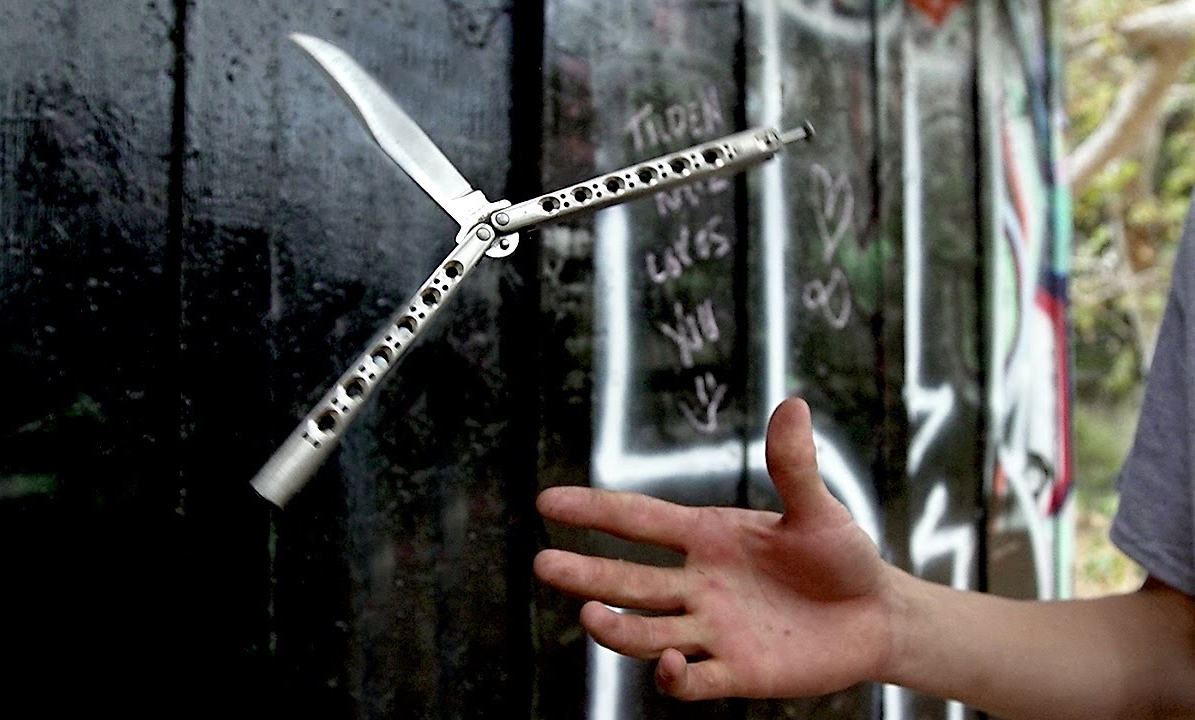The terms “bite handle,” “live blade,” “aerials,” “Loctite,” or “Squid Industries” mean very little to most people. For enthusiasts of balisong—the art of manipulating butterfly knives in different tricks and combinations—however, they are key vocabulary.
A butterfly knife, also known as a balisong or a Batangas knife, is a folding knife with two handles that can be rotated around to open and close. Balisongs originated in the Philippines, with versions of butterfly knives also existing in France for centuries. “Live” butterfly knives, or butterfly knives with sharp blades, hold varying legal statuses around the world: Some regions restrict ownership depending on the length of the blade, or allow collecting but not carrying. All live-bladed butterfly knives are prohibited in Canada. Instead, Canadian balisong enthusiasts use “trainers,” which are blunted or plastic butterfly knives, and are completely legal.
While people have been flipping butterfly knives for centuries, the sport only began to develop in the 21st century. Informal competitions among friends took place at knife shows like BLADE Show West in Oregon, which hosted its first live competition, the Bali Royal Showdown, in 2017.
Corbin Lovins, 2019 Bali Comp Champion, started taking flipping seriously in 2016 and has watched the competition scene grow since then.
“When I first got on the scene of flipping in 2016, competitions were strictly online,” Lovins wrote in an email to The McGill Tribune. “The online forums often had battles as well as the Facebook group [Balisong Flippers And Butterfly Knives] having Fliptober. Every year now it seems we have more competitions popping up.”
Lovins’s favorite part of competitions and the world of butterfly knives is the community he has found there.
“I fell in love with the community, the competitions, the constant progression [and] the [camaraderie] before the competition,” Lovins wrote. “[I have a] love of knives to where I have started to make my own. Every flipper [comes] together bonded by one interest: Balisongs.”
I first started flipping in the summer of 2019, when I stumbled across some YouTube tutorials. I ordered a cheap trainer, watched more videos, and immediately started practicing when it arrived. My knuckles quickly blistered from using improper form in vertical openings, I accidentally flung the trainer across the room trying to do fans, and I drove my parents crazy flipping at all hours. In short, I was hooked.
When purchasing new equipment, I stick with trainers even though butterfly knives are legal in my home state of New York because I’m not comfortable switching to the live blades—something very few people in the community judge me for. I absentmindedly practice my thumb rollovers and full twirls in Zoom lectures. I am by no means a naturally coordinated person, so landing my first basic aerial after working on it for hours was immensely satisfying and exhilarating.
Although I am an amateur flipper and have never been to a blade show or entered a competition, I’ve found the same community online. Experienced flippers are happy to give advice on which trainer to buy, applaud beginners’ first tricks, and commiserate over injuries acquired. The “gore” tag of the balisong subreddit is not for the faint of heart.
YouTube is a great place to start for anyone interested in balisongs. When learning how to flip, committing to tricks is crucial—hesitation is the best way to mess up. Lovins also suggests that beginners get involved in the community.
“Just sit back [and] learn the craft from the people who you notice are in that top tier division of flippers,” Lovins wrote. “Asking questions isn’t bad. Most [flippers] are always willing to answer questions and help you learn the art we have such a passion for.”
Balisong flipping truly is an art, and people who can overcome the initial intimidation of flipping around a knife for fun will discover just how captivating it can be.









